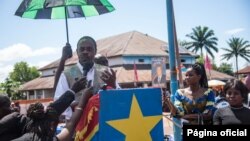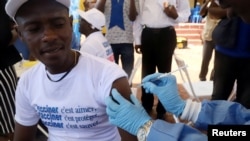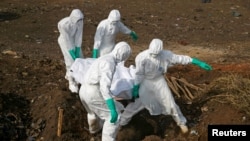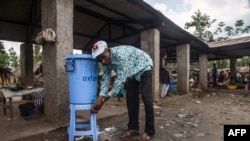Two Ebola patients who fled a hospital quarantine area in the Democratic Republic of the Congo later attended a prayer meeting, potentially exposing at least 50 participants to the dangerous virus.
The incident demonstrates the risks of limited public awareness of Ebola and how the virus spreads. So governments and aid groups are boosting efforts to educate the public as part of a broader response to an Ebola outbreak that as of Thursday was suspected in 52 cases of hemorrhagic fever. Of those, 31 have been confirmed as Ebola, with 13 likely and eight possible, the DRC health ministry said. The death toll was revised from 27 to 22, but it’s expected to grow.
“We try to raise awareness and tell people that, no matter their beliefs, it is crucial for patients to remain in health centers for treatment,” the health minister, Dr. Oly Ilunga Kalenga, told VOA in a phone interview. “This is part of the community awareness campaign, and it must continue and reach all groups in the population.
“Religious and traditional leaders must be involved, because there are many beliefs surrounding the Ebola virus,” Kalenga said, later adding that a pastor helped officials find one of the patients who fled.
How it starts, spreads
The disease, initially transmitted to humans from wild animals such as fruit bats, monkeys and forest antelope, spreads through direct contact with an infected person’s bodily fluids. Early symptoms can include fever, sore throat, fatigue, muscle pain and headache. Symptoms can take up to 21 days to emerge.
The outbreak’s epicenter is in a remote area of northwestern DRC, in Equateur province. Several cases have been confirmed in its provincial capital, Mbandaka, where the patients had fled from the Ebola treatment center. The city has more than 1 million residents, heightening the risk of further infection.
“The hospital where it currently is located is in the middle of the city, with many people coming and going,” Kalenga said. So health officials have decided to relocate the treatment center, run by Medecins Sans Frontieres (MSF) / Doctors Without Borders, to a site outside the city. That facility is expected to open later this week.
Coordinated messaging
Aid groups, coordinated by the World Health Organization, have been working to support the Congolese government’s response.
A Red Cross team arrived earlier this month in Equateur province with supplies including chlorine disinfectant, safe burial kits and informational posters.
“The most important tool that we have, the only tool to tackle viruses, is information and sharing it,” Julie Hall, special adviser on health for the International Federation of Red Cross and Red Crescent Societies (IFRC), said in a video clip posted Thursday on Twitter.
The IRFC also posted an animated, one-minute video explaining safe burial practices and why they should be observed.
Dangers of misinformation
WHO spokesman Tarik Jasarevic said health workers have hit stumbling blocks in explaining the risks of Ebola and how an experimental vaccine, introduced this week in Congo, might help.
Some people see Ebola as witchcraft, he told VOA. Health workers and burial teams have reported threats amid rumors that they’re bringing the disease with them.
Misinformation also helped fan the West Africa outbreak that began in late 2013 and, over the course of more than two years, killed at least 11,300 people in Guinea, Liberia and Sierra Leone. Reports surfaced of attacks on health workers or burial teams accused of disrespecting corpses.
It took aggressive, targeted messaging to allay fears and change behaviors, said Jennifer McQuiston, an official with the U.S. Centers for Disease Control and Prevention and an expert on infectious disease. She had deployed to Sierra Leone’s capital as the Ebola caseload there “started rising dramatically” in October 2014.
An international communications group had assembled 200 critical messages,important but hard to absorb at once, McQuiston recalled in a phone interview Thursday. So, guided by data on where and how Ebola was spreading, the group “came out with an Ebola ‘big idea of the week.’”
First up: “Safe burials save lives.” McQuiston said people were urged to accept burial teams with protective gear and disinfectant to safely remove bodies, characterizing this as an honorable measure. They also were encouraged to “pledge that if you died of Ebola, you would want your loved ones to give you a safe burial.”
Another week, the message was to “seek early treatment, to deconstruct the myth that people [with Ebola] were better off at home,” McQuiston said. “Going to an Ebola treatment center gives you a much better chance of surviving, and it’s going to save your family’s lives.”
Messages were delivered across radio, TV, social media and billboards, including in picture form, essential in areas with low literacy rates.
McQuiston’s detail lasted less than two months, and she returned to the United States.
“I actually went back to Sierra Leone a year later, in October 2015, and they were on the cusp of being declared Ebola-free” by WHO, she said. “They were proud. They changed their behavior.”
Control measures
With the current DRC outbreak, health experts have rolled out an information campaign that encourages vaccinations not only for front-line health workers but also for relatives and friends of those who have contracted Ebola. The WHO said some 10,000 people should be vaccinated within the next month.
Health officials are identifying and monitoring those who’ve come in contact with infected individuals.
Meanwhile, Kalenga said “all the people” traveling in and out of Mbandaka were being monitored for elevated temperature that might indicate infection. In the West African outbreak that began in late 2013 and killed more than 11,000, airport monitors used non-contact thermometers.
Nigeria, too, has reactivated temperature screening at its land borders, airports and seaports. The continent’s most populous country, with 186 million residents, experienced an outbreak in July 2014 that left seven dead. The WHO pronounced it Ebola-free that October.
Information campaigns also promote washing hands with a chlorine solution to kill the virus.
Handwashing stations have surfaced in public places. UNICEF has set up them up at entrances to schools, and teachers have been instructing students to forgo regular greetings of hugs or handshakes. During the West African outbreak, youngsters waved to or bumped elbows with each other.
This reporting originated in VOA’s Africa Division. Contributors include Paul Alexander and Carol Guensburg.




